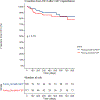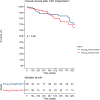Outcomes of conduction system pacing for cardiac resynchronization therapy in patients with heart failure: A multicenter experience
- PMID: 36842610
- PMCID: PMC10225322
- DOI: 10.1016/j.hrthm.2023.02.018
Outcomes of conduction system pacing for cardiac resynchronization therapy in patients with heart failure: A multicenter experience
Abstract
Background: Whether conduction system pacing (CSP) is an alternative option for cardiac resynchronization therapy (CRT) in patients with heart failure remains an area of active investigation.
Objective: The purpose of this study was to assess the echocardiographic and clinical outcomes of CSP compared to biventricular pacing (BiVP).
Methods: This multicenter retrospective study included patients who fulfilled CRT indications and received CSP. Patients with CSP were matched using propensity score matching and compared in a 1:1 ratio to patients who received BiVP. Echocardiographic and clinical outcomes were assessed. Response to CRT was defined as an absolute increase of ≥5% in left ventricular ejection fraction (LVEF) at 6 months post-CRT.
Results: A total of 238 patients were included. Mean age was 69.8 ± 12.5 years, and 66 (27.7%) were female. Sixty-nine patients (29%) had His-bundle pacing, 50 (21%) had left bundle branch area pacing, and 119 (50%) had BiVP. Mean follow-up duration in the CSP and BiVP groups was 269 ± 202 days and 304 ± 262 days, respectively (P = .293). The proportion of CRT responders was greater in the CSP group than in the BiVP group (74% vs 60%, respectively; P = .042). On Kaplan-Meier analysis, there was no statistically significant difference in the time to first heart failure hospitalization (log-rank P = .78) and overall survival (log-rank P = .68) between the CSP and BiVP groups.
Conclusion: In patients with heart failure and reduced ejection fraction, CSP resulted in greater improvement in LVEF compared to BiVP. Large-scale randomized trials are needed to validate these outcomes and further investigate the different options available for CSP.
Keywords: Cardiac resynchronization therapy; Conduction system pacing; Heart failure; His-bundle pacing; Left bundle branch area pacing; Physiological pacing.
Copyright © 2023 Heart Rhythm Society. Published by Elsevier Inc. All rights reserved.
Conflict of interest statement
All other authors have no relevant conflict of interest to disclose.
Figures





References
-
- Bristow MR, Saxon LA, Boehmer J, et al. Cardiac-resynchronization therapy with or without an implantable defibrillator in advanced chronic heart failure. N Engl J Med. 2004;350(21):2140–2150. - PubMed
-
- Moss AJ, Hall WJ, Cannom DS, et al. Cardiac-resynchronization therapy for the prevention of heart-failure events. New England Journal of Medicine. 2009;361(14):1329–1338. - PubMed
-
- Cleland JG, Daubert J-C, Erdmann E, et al. The effect of cardiac resynchronization on morbidity and mortality in heart failure. New England Journal of Medicine. 2005;352(15):1539–1549. - PubMed
-
- Tang AS, Wells GA, Talajic M, et al. Cardiac-resynchronization therapy for mild-to-moderate heart failure. New England Journal of Medicine. 2010;363(25):2385–2395. - PubMed
-
- Abraham WT, Hayes DL. Cardiac resynchronization therapy for heart failure. Circulation. 2003;108(21):2596–2603. - PubMed
Publication types
MeSH terms
Grants and funding
LinkOut - more resources
Full Text Sources
Medical
Research Materials

